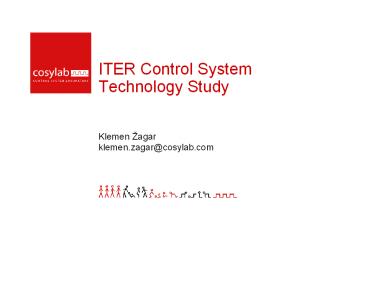ITER Control System Technology Study PowerPoint PPT Presentation
Title: ITER Control System Technology Study
1
ITER Control System Technology Study
Klemen agar klemen.zagar_at_cosylab.com
2
Overview
- About ITER
- ITER Control and Data Acquisition System (CODAC)
architecture - Communication technologies for the Plant
Operation Network - Use cases/requirements
- Performance benchmark
3
A Note!
- Information about ITER and CODAC architecture
presented here-in is a summary of ITER
Organizations presentations - Cosylab prepared studies on communication
technologies for ITER
4
About ITER (International Thermonuclear
Experimental Reactor)
5
About ITER
29m
28m
6
CODAC Architecture
7
Plant Operation Network (PON)
- Command Invocation
- Data Streaming
- Event Handling
- Monitoring
- Bulk Data Transfer
- PON self-diagnostics
- Diagnosing problems in the PON
- Monitoring the load of the PON network
- Process Control
- Reacting on events in the control system by
issuing commands or transmitting other events - Alarm Handling
- Transmission of notification of anomalous
behavior - Management of currently active alarm states
8
Prototype and Benchmarking
- We have measured latency and throughput in a
controlled test environment - Allows side-by-side comparison
- Also, hands-on experience is more comparable
- Latency test
- Where a central service is involved (OmniNotify,
IceStorm or EPICS/CA) - Send a message (to the central service)
- Upon receipt on the sender node, measure
difference between send and receive times - Without a central service (OmniORB, ICE, RTI
DDS) - Round-trip test
- Send a message (to the receiving node)
- Respond
- Upon receipt of the response, measure the
difference - Throughput test
- Send messages as fast as possible
- Measure differences between receive times
- Statistical analysis to obtain average, jitter,
minimum, 95th percentile, etc.
9
Applicability to Use Cases
- First number performance
- Second number functional applicability of the
use case
- not applicable at all
- applicable, but at a significant
performance/quality cost compared to optimal
solution custom design required - applicable, but at some performance/quality cost
compared to optimal solution custom design
required - applicable, but at some performance/quality cost
compared to optimal solution foreseen in
existing design - applicable, and close to optimal solution use
case foreseen in design
10
Applicability to Use Cases
- First number performance
- Second number functional applicability of the
use case
- not applicable at all
- applicable, but at a significant
performance/quality cost compared to optimal
solution custom design required - applicable, but at some performance/quality cost
compared to optimal solution custom design
required - applicable, but at some performance/quality cost
compared to optimal solution foreseen in
existing design - applicable, and close to optimal solution use
case foreseen in design
11
PON Latency (small payloads)
12
PON Latency (small payloads)
- Ranking
- OmniORB (one way invocations)
- ICE (one way invocations)
- RTI DDS (not tuned for latency)
- EPICS
- OmniNotify
- ICE storm
13
PON Throughput
14
PON Throughput
- Ranking
- RTI DDS
- OmniORB (one way invocations)
- ICE (one way invocations)
- EPICS
- ICE storm
- OmniNotify
15
PON Scalability
- RTI DDS efficiently leverages IP multicasting
- (source RTI)
- With technologies that do not use IP
multicasting/broadcasting, per-subscriber
throughput is inversely proportional to the
number of subscribers! - (source RTI)
16
EPICS
- Ultimately, ITER Organization has chosen EPICS
- Very good performance.
- Easiest to work with.
- Very robust.
- Full-blown control system infrastructure (not
just middleware). - Likely to be around for a while (widely used by
many labs). - Where EPICS could improve?
- Use IP multicasting for monitors.
- A remote procedure call layer (e.g., abuse
waveforms to transmit data serialized with with
Google Protocol Buffers, or use PVData in
EPICSv4).
17
- Thank You for Your Attention

